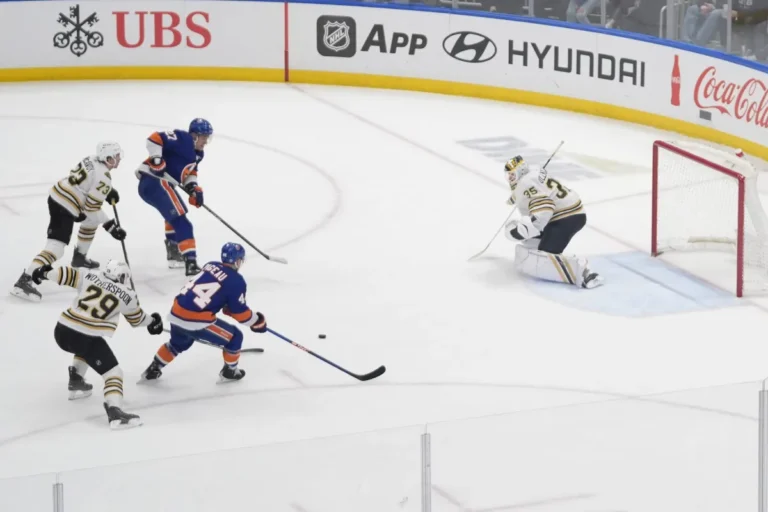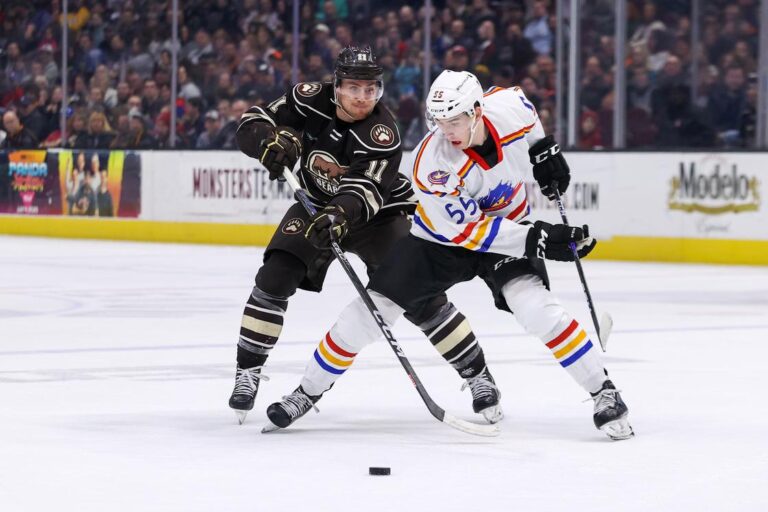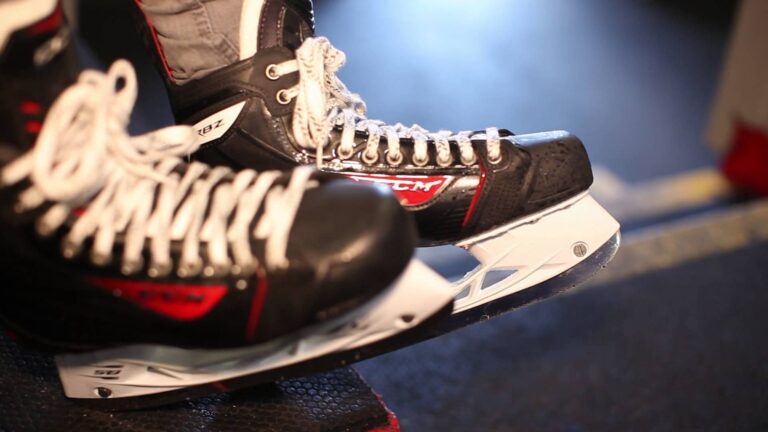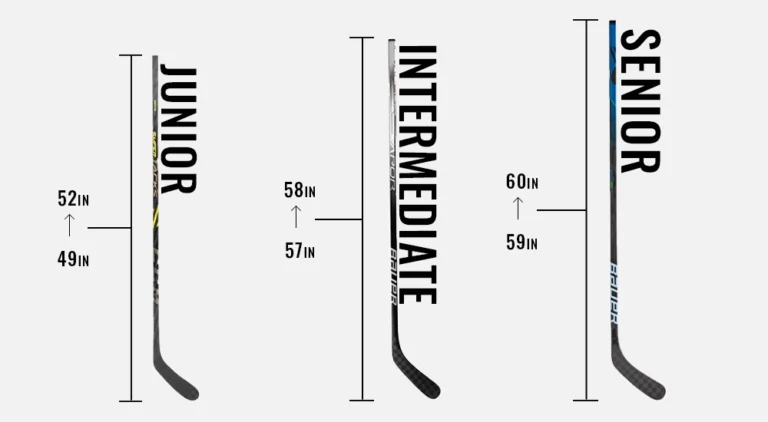What is Hockey Forecheck? A Game-Changing Strategy

Hockey forecheck refers to the strategy of applying pressure on the opposing team to disrupt their offensive play and regain possession of the puck. It involves aggressive positioning and quick, coordinated movements to force turnovers and create scoring opportunities.
Hockey forecheck is a crucial element of the game, as it can dictate the pace and flow of play. Teams use various forechecking systems, such as the aggressive 2-1-2 or the passive 1-2-2, to apply pressure based on the game situation.
Successful forechecking requires strong communication, anticipation, and teamwork among players. By understanding the concept of hockey forecheck and its different strategies, players can enhance their overall performance on the ice. This article will delve deeper into the importance of forechecking in hockey and how it contributes to a team’s success. Understanding the ins and outs of forechecking can give players and fans a deeper appreciation for the game and its strategic elements.

Credit: bvmsports.com
Understanding Hockey Forecheck
Hockey forecheck involves strategically pressuring the opposing team in their defensive zone to disrupt their plays and regain control of the puck. This aggressive tactic can be crucial in gaining an advantage and creating scoring opportunities.
What is Forechecking?
In ice hockey, forechecking refers to the strategic tactic of putting pressure on the opposing team when they have possession of the puck in their defensive zone. It is a proactive method used to disrupt the opponent’s ability to move the puck up the ice and create scoring opportunities. Players perform various types of forechecking depending on the team’s overall game plan and the specific game situation.
Importance of Forechecking
Forechecking plays a crucial role in a team’s overall defensive strategy and their ability to regain possession of the puck. Pressuring the opposing team deep in their defensive zone, it can lead to turnovers, creating scoring chances and preventing the other team from setting up their offensive plays. Successful forechecking also helps to keep the momentum in a team’s favor and can contribute to maintaining control of the game.
When executed effectively, forechecking can force the opposing team to make hurried decisions, leading to errors and turnovers that can be capitalized upon. It also aids in disrupting the flow of the game for the other team, making it difficult for them to execute their offensive tactics.
In conclusion, understanding the concept of forechecking is essential for any hockey player and team. It is a fundamental component of the game that impacts both defensive and offensive aspects, contributing significantly to a team’s overall performance.
Types Of Hockey Forecheck
Hockey forechecking is a crucial strategic aspect of the game that involves putting pressure on the opposing team to regain possession of the puck. Understanding the various types of forechecks can provide insight into different offensive tactics. Let’s explore the three common types of hockey forecheck: 1-2-2, 2-1-2, and 1-3-1.
1-2-2 Forecheck
This strategy involves sending one player into the offensive zone to pressure the puck carrier, supported by two forwards positioned at the blue line and two defensemen guarding the neutral zone. The goal is to force turnovers and disrupt the opponent’s breakout, creating scoring opportunities.
2-1-2 Forecheck
In this approach, two forwards initiate the forecheck deep in the offensive zone, applying pressure to the opposing team’s defensemen, while one forward supports them. Meanwhile, the two defensemen remain closer to the center ice, ready to defend against counter-attacks and maintain possession in the offensive zone.
1-3-1 Forecheck
The 1-3-1 forecheck entails sending a single forward aggressively into the offensive zone, backed by three forwards positioned in the neutral zone and a defenseman at the blue line. This setup aims to limit the opposing team’s breakout options and create turnovers, allowing for quick transitions to offensive opportunities.
Strategies And Tactics For Effective Forechecking
Forechecking is a critical component of ice hockey that can disrupt the opponent’s breakout, create scoring opportunities, and ultimately lead to victory. To effectively forecheck, teams need to employ various strategies and tactics tailored to their playing style and situation. In this article, we will explore three key aspects of effective forechecking:
1. Reading Opponent’s Breakout
One of the essential strategies for successful forechecking is reading the opponent’s breakout. By studying their tendencies and positioning, teams can anticipate the direction of the breakout pass and position their players accordingly. This can be achieved through:
- Scouting the opposing team’s previous games for patterns and tendencies.
- Observing the positioning of the opponent’s players during the breakout.
- Analyzing passing options available to the opponent.
2. Pressure Points In The Offensive Zone
To effectively forecheck, it is crucial to identify and target pressure points in the offensive zone. These are areas where the defending team can apply pressure to force turnovers and regain possession. Common pressure points include:
- The corners: By pressuring the opponent in the corners, teams can limit their passing options and force turnovers near the boards.
- Behind the net: Pressuring the opposition behind their net can disrupt their breakout and lead to turnovers or interceptions.
- The point: Applying pressure at the point can disrupt the opponent’s ability to maintain possession and execute clean breakouts.
3. Creating Turnovers
A key objective of forechecking is to create turnovers and regain possession of the puck. Here are some effective tactics for creating turnovers:
| Tactic | Description |
|---|---|
| Stick checking | Using the stick to disrupt puck control and force turnovers. |
| Body checking | Delivering a well-timed body check to separate the opponent from the puck. |
| Interceptions | Anticipating the opponent’s passes and intercepting the puck. |
| Net-front pressure | Applying pressure around the opposing team’s net to create scoring chances and force mistakes. |
By combining these strategies and tactics, teams can significantly increase their chances of effective forechecking and ultimately gain an upper hand in their games. Understanding the opponent’s breakout, targeting pressure points in the offensive zone, and creating turnovers are essential pillars of successful forechecking.
/cdn.vox-cdn.com/uploads/chorus_image/image/72252304/1487404101.0.jpg)
Credit: www.allaboutthejersey.com
Role Of Players In The Forechecking System
In hockey forecheck, players play a critical role in pressuring the opponent and disrupting their play. They aim to regain control of the puck by applying aggressive tactics, such as blocking passing lanes and creating turnovers. This active approach requires precision and teamwork to effectively execute the forechecking system.
Forechecking In Hockey: The Role Of Players
In the fast-paced game of hockey, forechecking plays a crucial role in both offensive and defensive strategies. It is a system that requires coordination and teamwork from players across different positions. Understanding the specific responsibilities of forwards, defensemen, and goaltenders in the forechecking system is essential to maximize its effectiveness. Let’s explore how each player contributes to this dynamic tactic:
Forwards’ Responsibilities
Forwards are the primary initiators of the forechecking system, aiming to disrupt the opposing team’s breakout and regain control of the puck. Their responsibilities within this strategy include:
- Pressuring the Puck Carrier: The forwards relentlessly pursue the opposing team’s player who has possession of the puck in their defensive zone. This pressure forces the opponent into making hasty decisions and decreases their chances of executing successful passes or creating scoring opportunities.
- Blocking Passing Lanes: By positioning themselves strategically, forwards aim to block the passing lanes of the opposing team’s defenders. This disrupts the flow of the breakouts and limits the available options for the puck carrier, increasing the chances of intercepting a pass or causing a turnover.
- Creating Physical Contact: Forwards apply physical pressure on the opposing players, which can lead to turnovers, create momentum shifts, and even tire out the opponents. This aggressive play style can help regain control of the puck and shift the game’s tempo in favor of the team.
Defensemen’s Responsibilities
Defensemen play a crucial role in supporting the forechecking system by providing a solid defensive foundation. While their primary focus is on defending their territory, they also have vital responsibilities in the offensive transition. Here’s what defensemen typically need to do:
- Cutting Off Passing Lanes: One of the defensemen’s key tasks is to anticipate the opponent’s passing options and cut off those lanes. By positioning themselves strategically, they can intercept passes or force the puck carrier into making undesirable decisions, leading to turnovers.
- Supporting the Forwards: Defensemen need to support the forwards in their forechecking efforts. This can involve stepping up and challenging the puck carrier or providing backside support to ensure defensive coverage.
- Managing the Offensive Transition: When their team gains possession of the puck, defensemen must quickly transition to the offensive phase. This includes making accurate breakout passes, joining the rush, or providing offensive support by creating opportunities around the opposing team’s net.
Goaltender’s Role
Although the goaltender does not directly participate in the forechecking system, their role is still vital in ensuring its success. The goaltender’s primary responsibility is to protect the net and prevent any shots from entering. However, when the opposing team is breaking out, the goaltender can:
- Communicate with Defensemen: The goaltender communicates with the defensemen, providing guidance on the positioning of opposing players and alerting them to any immediate threats. This allows the defensemen to adjust their tactics and provide better support during forechecking.
- Act as an Extra Skater: In situations where the opponent’s net is empty due to an extra attacker, the goaltender can leave their net to act as an extra skater during a strong forechecking push. This adds additional pressure on the opposing team and increases the chances of regaining possession.
- Retrieve Dumped Pucks: Occasionally, the opposing team may choose to dump the puck into the defensive zone to evade forechecking pressure. In such cases, the goaltender must be prepared to leave their net and retrieve the puck, effectively becoming an extra defenseman. This prevents the opposition from setting up any offensive chances.
The forechecking system relies on the coordinated effort of forwards, defensemen, and goaltenders. By understanding and executing their respective roles, teams can enhance their offensive and defensive capabilities, gain more control over the game, and create scoring opportunities. Effective forechecking can be a game-changer, tipping the scales in favor of the team that masters this dynamic strategy.
Case Studies Of Successful Forechecking Teams
When it comes to hockey forechecking, certain teams have mastered the art and have achieved remarkable success on the ice. In this section, we will explore three case studies of successful forechecking teams: the Pittsburgh Penguins, the St. Louis Blues, and the Tampa Bay Lightning. These teams have demonstrated their prowess in forechecking techniques, enabling them to dominate their opponents and win championships.
Pittsburgh Penguins
The Pittsburgh Penguins have been hailed as one of the most formidable forechecking teams in the NHL. Their aggressive and relentless forecheck has become their trademark, allowing them to gain control of the puck and mount constant offensive pressure on their opponents. With skilled forwards like Sidney Crosby and Evgeni Malkin leading the charge, the Penguins utilize an aggressive 2-1-2 forecheck strategy, which involves two forwards pressuring the opposing team’s defensemen while the third forward covers the center zone.
St. Louis Blues
The St. Louis Blues have found tremendous success with their effective forechecking system. Under the leadership of their head coach, Craig Berube, the team has adopted an aggressive 1-2-1-1 forecheck strategy, which puts significant pressure on their opponents in the offensive zone. The Blues’ forechecking game is characterized by their physicality and strong puck pursuit, disrupting their opponents’ breakout plays and forcing turnovers. This strategy, combined with a solid defensive structure, has allowed the Blues to excel and secure their first-ever Stanley Cup championship in the 2018-2019 season.
Tampa Bay Lightning
The Tampa Bay Lightning’s forechecking prowess has played a crucial role in their success as a perennial contender in the NHL. Led by their talented roster and astute coaching staff, the Lightning implement an aggressive and high-pressure 2-1-2 forecheck system, applying relentless pressure on the opposition’s defensemen and creating turnovers. Their speed, skill, and hockey IQ provide them with the necessary tools to excel in the offensive zone and generate scoring opportunities. The Lightning’s commitment to strong forechecking has propelled them to multiple deep playoff runs and the 2020-2021 Stanley Cup championship.
In conclusion, studying successful forechecking teams like the Pittsburgh Penguins, St. Louis Blues, and Tampa Bay Lightning provides invaluable insights into the strategies and tactics that contribute to their achievements on the ice. By adopting and adapting aspects of their forechecking systems, other teams can strive to emulate their success and elevate their game to new heights.

Credit: www.nhl.com
Frequently Asked Questions Of What Is Hockey Forecheck
What Is The Difference Between Backcheck And Forecheck?
Backcheck occurs in the defensive zone to stop an opponent’s attack. Forecheck happens in the offensive zone to pressure the opposing team.
What Is The 1 2 2 Forecheck In Hockey?
The 1 2 2 forecheck in hockey is a strategic system where one player pressures the puck carrier, two players support and contain, and two players defend in the neutral zone. It is designed to control play and create turnovers to generate offensive opportunities.
How Do You Teach Forechecking In Hockey?
To teach forechecking in hockey, focus on positioning players to pressure opponents, disrupt their plays, and regain control of the puck. Emphasize techniques like angling, stick checks, and body checks. Encourage communication and teamwork to effectively execute forechecking strategies. Practice drills that simulate game situations to improve players’ understanding and execution of forechecking tactics.
What Is F1 F2 F3 Forecheck?
F1, F2, and F3 forecheck are hockey strategies where players pressure the opposing team in their own zone. F1 forecheck refers to the forward closest to the puck carrier, F2 is the next forward, and F3 is the high forward. They aim to disrupt the opponents’ breakout and create turnovers for scoring chances.
Conclusion
Understanding the concept of hockey forecheck is crucial for players and coaches alike. By implementing effective forechecking strategies, teams can disrupt their opponents’ offensive plays and increase their chances of scoring goals. Whether it’s the aggressive and relentless style of the 2-1-2 forecheck or the passive pressure approach of the 1-2-2, mastering these tactics can elevate a team’s performance on the ice.
So, next time you watch a game, keep an eye out for the forecheck and appreciate its significance in shaping the outcome.






